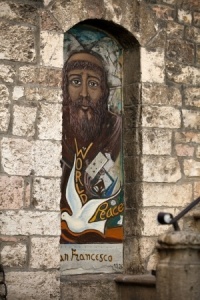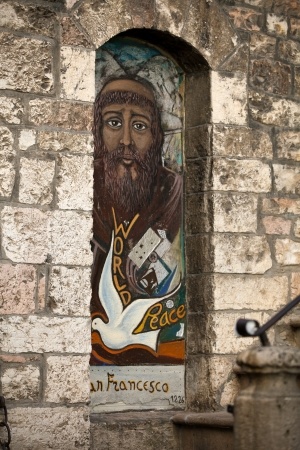
Back in the 1980s, Come to the Quiet by John Michael Talbot was one of my favorite cassette tapes. And his version of the “Peace Prayer of St. Francis” was one of my favorite songs on the tape. When I decided to write on the connection of the Peace Prayer to Alcoholics Anonymous, I discovered that John Michael Talbot is still around, making music and doing an evangelistic ministry. His look has changed. Now he sports a very long white and grey beard. Think ZZ Top and John the Baptist rolled into one.
The origins of the Peace Prayer of St. Francis are actually in 20th century France, not the writings of Francis of Assisi. In 1912 it appeared anonymously in a small French magazine, La Clochette (The Little Bell), published by a French priest, Father Esther Bouquerl. In 1915, it was sent to Pope Benedict XV and published the following year in the Vatican’s daily newspaper. Around 1920, it was printed on the back of an image of St. Francis and titled “Prayer for Peace.” It was first attributed to St. Francis in 1927 by a French Protestant movement, The Knights of the Prince of Peace.
The first known English translation was in a 1936 book by Kirby Page titled: Living Courageously. Kirby was a Disciple of Christ minister and the editor of a pacifist magazine called “The World Tomorrow;” not to be confused with the long running radio and television program by Herbert W. Armstrong or the more recent 2012 political talk show hosted by Julian Assange. Page clearly and specifically attributed the origins of the “Peace Prayer” to St. Francis of Assisi. During World War II and afterwards, it had a wide circulation as the “Prayer of St. Francis” especially through the books of Francis Spellman, who became the archbishop of New York City in 1939, the year the A.A. Big Book, Alcoholics Anonymous, was published. A.A.’s headquarters and Bill W., cofounder of A.A., were both in NYC.
In a December 1952 article for the AA Grapevine, Bill W. presented Francis of Assisi as an example of an individual who was able to practice “the spirit of Christmas” every day of the year. Bill thought that regardless of what an individual may call it, “the spirit of Christmas is in us all.” After describing the life of Francis and the vision Francis had after he “hit bottom” during a long illness, Bill presented the “Peace Prayer of St. Francis” as “the prayer he [Francis] so often spoke.” Bill then concluded his reflections stating that Francis left us a clear example of how to live our lives: “Freely ye have received; Freely give.”
When Bill W. wrote the essay for “Step Eleven” in the A.A. book, Twelve Steps and Twelve Traditions, he suggested it as a beginning for those trying to apply the meditation and prayer to recovery that the Eleventh Step encouraged. The Eleventh Step reads: “Sought through prayer and meditation to improve our conscious contact with God as we understood Him, praying only for knowledge of His will for us and the power to carry that out.” Within A.A., the Peace Prayer has become known as “the Eleventh Step Prayer.” In 1958, Bill wrote the “Prayer of St. Francis” in the AA Grapevine and described how he used Peace Prayer to overcome depression. He said:
Of course, I haven’t offered you a really new idea–only a gimmick [the Peace Prayer] that has started to unhook several of my own “hexes” at depth. Nowadays my brain no longer races compulsively in either elation, grandiosity or depression. I have been given a quiet place in bright sunshine.
A final indication of the importance of the Peace Prayer to Bill was that it was recited in a private memorial service when he died. And it was credited in Pass It On to be his favorite prayer. Here it is:
Lord make me an instrument of your peace
Where there is hatred,
Let me sow love;
Where there is injury, pardon;
Where there is error, truth;
Where there is doubt, faith;
Where there is despair, hope;
Where there is darkness, light;
And where there is sadness, Joy.O Divine Master grant that I may not so much seek to be consoled
As to console;
To be understood, as to understand;
To be loved, as to love.
For it is in giving that we receive,
It is in pardoning that we are pardoned,
And it is in dying that we are born to eternal life.
Although Bill saw the Peace Prayer as applying to individuals of any faith background, to do so, the “Lord” and “Divine Master” of the prayer will have to be seen in the generic sense of God as we understood Him. Yet the Christian sense of who was “Lord” in the prayer was never in doubt. Even from its own anonymous beginnings it was referring to Jesus Christ. “If you confess with your mouth that Jesus is Lord and believe in your heart that God raised him from the dead, you will be saved. (Romans 10:9)”
Even if we look to the Peace Prayer as a blueprint to how all people should treat one another as Bill W. did, it elaborates the second greatest commandment of loving your neighbor as yourself (Mark 12:31). And when someone who does not confess Jesus as Lord still tries to live out the truth of the Peace Prayer in his or her life, we can say as Jesus did to the scribe in the Mark 12 passage, “You are not far from the kingdom of God. (Mark 12:34)”





